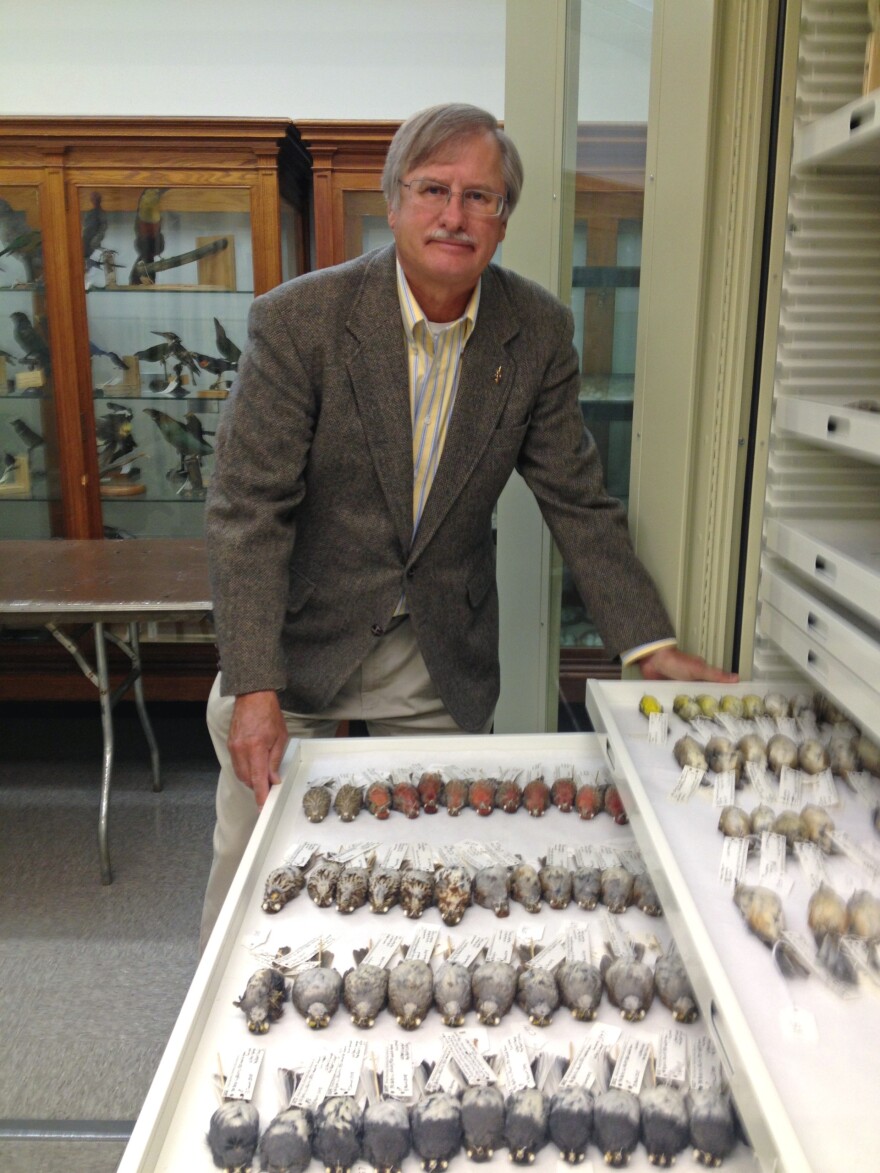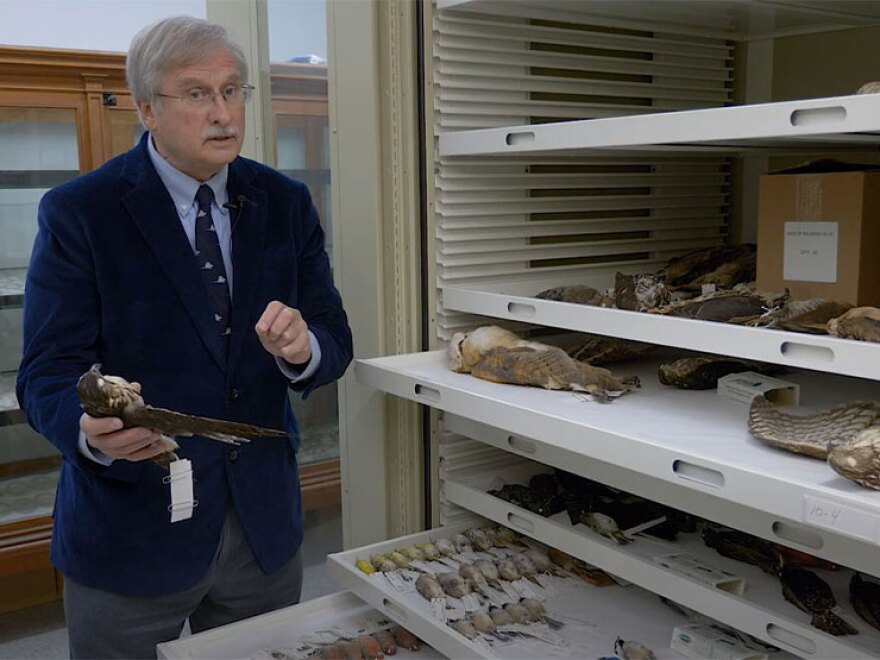ALLENTOWN, Pa. — There's no time of the day, nor season of the year, during which birds are not vulnerable to window strikes.
“And the reason is the nature of the problem,” said Daniel Klem, director of the Acopian Center for Ornithology at Muhlenberg College. “The nature of the problem is the birds don't see it. It's invisible to them.
“And they get killed flying into reflective illusions, or they get killed trying to reach habitat behind clear panes, like in corridors or atria, or things like that.”
While the dangers human infrastructure pose to birds year-round has been well-documented by Klem, as well as others, for decades, he and two other Lehigh Valley researchers are arguing fatalities are much higher than we might think.
They recently published a peer-reviewed study showing bird deaths from window strikes are nearly double previous estimates, and likely higher.
“This study reveals 3.5 million birds dying every day in a 365-day period.”Daniel Klem, director of the Acopian Center for Ornithology at Muhlenberg College
“This study offers a new estimate that expands upon previous studies, documenting a far greater threat,” said Klem, who is also a professor of ornithology and conservation biology. “The previous estimate had a minimum of, an easy way to say it is one million birds dying a day.
“This study reveals 3.5 million birds dying every day in a 365-day period.”
The article, "Evidence, Consequences, and Angle of Strike of Bird–Window Collisions," was published in the March issue of “The Wilson Journal of Ornithology.” It was co-authored by Klem, Acopian Ornithological Specialist Peter G. Saenger and former student researcher Brandon P. Brogle.
‘Missing something like 350%’
Klem and others conducted a series of these experiments where they tracked birds that flew toward windows, noting individual behavior patterns and movements.
“From that, we were able to determine exactly what happened to the outcome of those birds,” he said. “Did they die immediately after they struck? Did they hit and then fly away? What kind of evidence did they leave behind when they hit? Were they stunned?
“And this is the part of the equation that permits us to accurately add how many more birds are dying that we didn't know about before.”
Researchers noted how many birds were stunned by a strike and could be taken to an animal rehabilitation center. However, the chances of recovery after a strike are slim. Another study showed 70% of all animals that were brought to centers after striking windows died.
"We were missing something like 350% of the birds.”Daniel Klem, director of the Acopian Center for Ornithology at Muhlenberg College
“We used that 70% figure and we took how many birds were stunted in our experiments,” he explained. “And then we were able to extrapolate what the mortality would be beyond just the carcass rate.
“That provided us with the fact that we were missing something like 350% of the birds.”
The study also showed how little evidence is left behind after bird-window collisions, which can also exacerbate underreported numbers.
“Fifty percent of the birds in our experiment left no evidence of a strike at all,” Klem said.
Overall, they tracked 1,356 birds that struck windows. The vast majority, 90%, were direct hits, the rest just glancing blows.
“Of those animals that hit directly or indirectly, glancing blows or direct glows, the outcome was proportionately the same,” Klem said. “Most of them, 81% to 84%, were totally unharmed and seemed to fly off immediately. Twelve to 14% were stunned, and 2% died immediately.”
‘A major source of mortality’
Last week, Klem spoke at a conservation event at Franklin & Marshall College, sponsored by the college and the Lancaster County Bird Club. Called "Saving Birds: The Science Behind Bird-Glass Collisions and the Need for Bird-Friendly Buildings," focused on raising awareness about bird collisions and the push for bird-friendly building designs.
In a news release ahead of the event, Ted Nichols II, president of the Lancaster County Bird Club, said fatalities from bird-window collisions “is, in its own way, becoming the DDT of the 21st century.”
DDT, or dichloro-diphenyl-trichloroethane, was developed in the 1940s as the first modern synthetic insecticide, according to the Environmental Protection Agency. However, it was banned in 1972 after its use was linked to a decline of bald eagle and other bird-of-prey populations.
“Increasingly, it is clear that bird-glass collisions are a major source of mortality for birds, especially migratory birds,” said Dan Ardia, a professor and associate dean of the faculty at F&M College. “Yet the solutions to this pressing conservation issue are complicated.”
The event brought together “scientists, conservationists, and the mitigation community to discuss emerging research and practical solutions to help address the impact of the built environment on the natural world.”
‘How to transform a window into a barrier’
While house cats and city lights have often been the scapegoat in bird deaths, common sense instead points to windows, Klem argues.
“Cats take the vulnerable animals and windows take the strongest as well as the vulnerable animals – it’s an indiscriminate killer,” he said, adding the scavenging of skunks, raccoons, possums and even squirrels and chipmunks have compromised the data. “Then there's the whole issue of how many cats there are in the world versus how many windows.
“There's astronomically more window panes around the globe and in the United States, and there are domestic cats. And so, common sense would always say the numbers for cats being higher than windows really doesn't seem to click or make sense.”

And, while lights and vegetation attract birds to “the killing zone,” they aren’t to blame.
“If those lights were really bringing the birds crashing into buildings, you'd have 1,000 or 2,000 birds dying every day — not just once, in a season or once every four years,” he said. “It's the unusual weather conditions that bring these animals into the contact of the concrete and glass canyons in cities that cause the problem.
“They just don’t see the glass.”
The study offers some evidence and provides some rationale to elevate windows as the prime culprit of bird fatalities, he said. While common sense dictated the answer to Klem, he now has data and evidence, too.
“For 50 years, a half a century, I've been studying, writing and teaching about this topic to try to get a critical mass of people to do something about the architecture and development range,” Klem said, noting the book he wrote in 2021, “Solid Air: Invisible Killer – Saving Billions of Birds from Windows.”
“Fundamentally, we know from my studies how to transform a window into a barrier that birds will see and avoid,” he said. “And the bottom line is a unique patterning that uniformly covers the windows. The elements that make up these patterns, whether they're lines or dots, or diamonds or circles, they need to be spaced 4 inches, 10 centimeters if they're oriented in vertical columns, or 2 inches, 5 centimeters, if they're oriented in horizontal rows.
“And if you do that, you solve the problem.”

Businesses have cropped up in response, both to retrofit existing windows and for new construction. For example, Canada-based Feather Friendly produces a window film and Guardian Glass, headquartered in Michigan, has created bird-friendly glass.
“The whole world has to be retrofitted to save the birds, because they're dying everywhere,” Klem said. “Wherever birds and glass occur, they get killed.”
Want to see bird-friendly windows up close? Muhlenberg’s newest building, the Fahy Commons for Public Engagement and Innovation, 2400 W. Chew St., features triple-paned, dotted windows, smaller ones with a film, while the larger ones are acid-etched, to prevent bird strikes.


